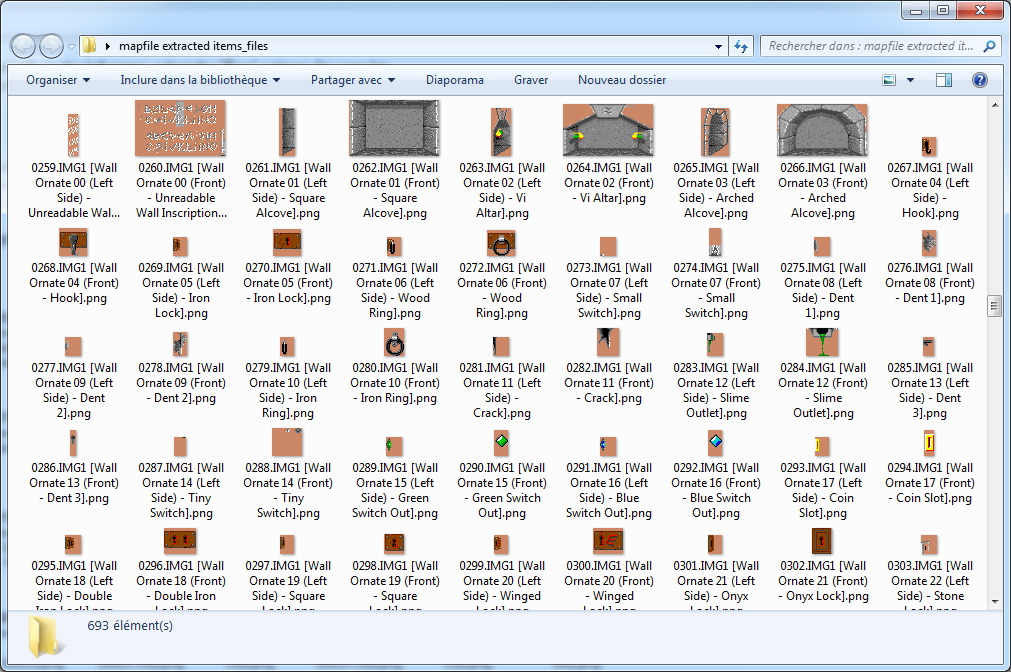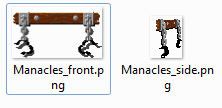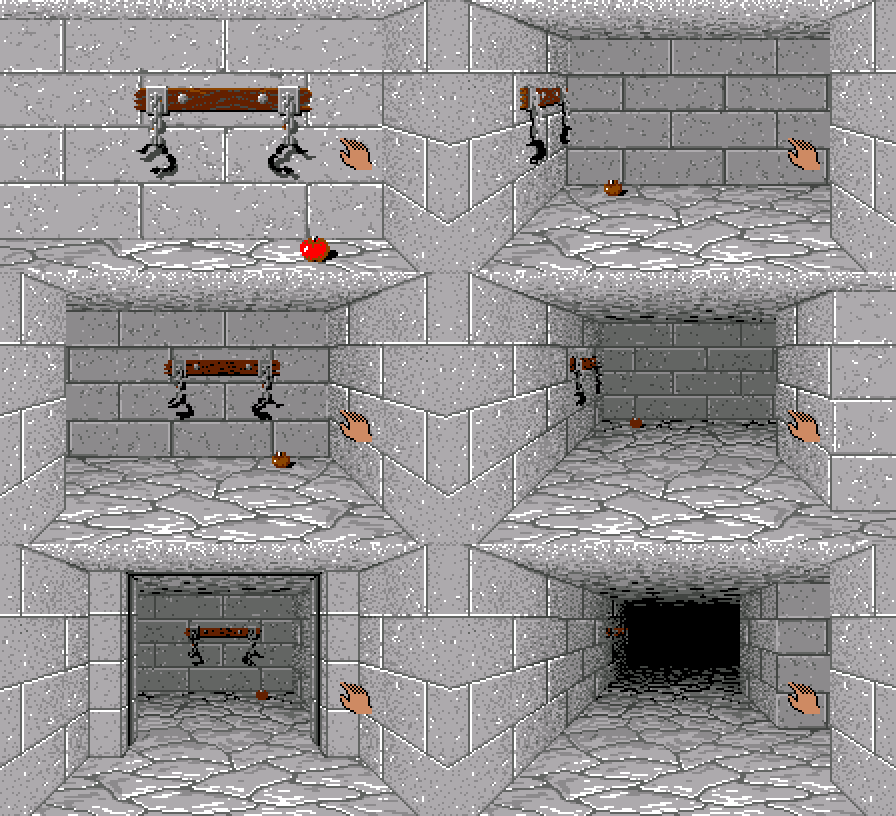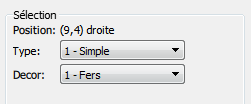Téléchargements
Exécutable de l'éditeur de niveaux (Windows 32bits)
Le jeu ne devrait pas fonctionner dans cette partie. Je corrigerai ça dans la prochaine.
Avant d'essayer de compiler le code, allez dans l'onglet "Projets" dans le menu de gauche, séléctionnez l'onglet "Run" pour votre kit,
et mettez dans "Working directory" le chemin de "editor\data" pour l'éditeur.
Les décors
Ils peuvent être purement décoratifs - mousse, crochets, fers... - mais ils peuvent aussi être des éléments interactifs comme des boutons, des leviers,
les tableaux des champions dans le premier niveau, les serrures, les autels ou les textes écrits sur les murs.
Voici un aperçu rapide des décors dans les graphismes d'origine.

Maintenant essayons d'afficher un simple décor (disons les "fers" parce qu'ils sont gros).
Quand on regarde les graphismes pour les fers, on voit qu'il y a seulement 2 sprites, un de face et un pour le coté gauche.

Mais dans le jeu on peut les voir sur différents murs, loins ou proches:

Alors comment ça marche ?
D'abord il est évident que si le décor doit apparaitre sur un mur de droite au lieu d'un mur de gauche, l'image pour la gauche a simplement été
retournée horizontalement.
Ensuite, comme vous pouvez le voir, plus le mur est loin, plus le décor apparait petit.
A l'époque, il y avait peu d'ordinateurs avec des sprites zoomés. Donc les versions réduites des décors étaient précalculés au début du jeu.
Les routine graphiques qu'on utilise peuvent étirer les images, donc on n'aura pas besoin de les précalculer. En fait, si vous avez regardé les
sources quand on retournait les murs dans la partie précédente, on faisait une mise à l'échelle de -1 sur l'axe des X.
Les images apparaissent aussi plus sombres quand elles sont plus loin de nous, pour s'accorder à la couleur des murs. C'est clairement visible sur
la pomme, et un peu moins perceptible sur les fers.
C'est parce qu'il y a une autre limitation à prendre en compte. Les graphismes du jeu étaient pallétisés, donc quand ils étaient précalculés,
les pixels pouvaient seulement prendre un petit nombre de couleurs.
On n'aura pas cette limitation non plus, donc nos décors devraient être plus jolis.
Mais nous parlerons des détails de l'affichage plus tard. Maintenant créons une base de données qui contienne les informations dont on aura besoin.
On l'appellera "ornates.xml":
<?xml version="1.0" encoding="ISO-8859-1"?>
<ornates>
<ornate name="Aucun">
</ornate>
<ornate name="Fers">
<image_front>Manacles_front.png</image_front>
<image_side>Manacles_side.png</image_side>
<pos_front x="66" y="71"/>
<pos_side x="30" y="73"/>
</ornate>
</ornates>
Le jeu lira toutes ces données et calculera les positions pour les images réduites en fonction des positions des murs.
Cette base de données sera aussi copiée dans le répertoire "data" de l'éditeur. L'éditeur aura seulement besoin des noms des décors.
Note pour plus tard: Il faudra que je réorganise les répertoires "data" pour éviter ces copies...
Mais ragardons comment nous allons ajouter les décors dans l'éditeur.
Paramètres additionnels dans "walls.xml"

Mais la 2ième ComboBox ne sera pas créée comme la première. En fait il va nous falloir des paramètres différents pour chaque type de mur.
Disons par exemple que ce premier type sera un mur simple avec seulement un "ornate" décoratif.
Le type 2 pourrait être un mur avec un texte, donc il nous faudra un un paramètre de type "texte".
Le 3ième type serait pour les boutons et les leviers, donc on aurait 2 ComboBoxes de décor (une pour l'état off, et une pour l'état on)
et peut-être un paramètre booléen pour stocker l'état du bouton.
Et ainsi de suite.
Pour que ça soit flexible, on ne va pas hard-coder ces types dans l'éditeur.
Donc il faudra qu'on crée dynamiquement les ComboBoxes, les champs de texte, et autres boutons pour ces paramètres.
D'abord on va modifier "walls.xml" pour définir notre paramètre additionnel:
<?xml version="1.0" encoding="ISO-8859-1"?>
<walls>
<wall name="Rien">
</wall>
<wall name="Simple">
<image>Wall.png</image>
<param type="ornate">Decor</param>
</wall>
</walls>
enum EParamType
{
eParamOrnate = 0,
};
struct CParamType
{
EParamType mType;
QString mName;
};
class CMap
{
[...]
std::vector<std::vector<CParamType>> mWallsParams; // liste des paramètres pour chaque type de mur
[...]
};
Il faut qu'on modifie readWallsDB() pour lire ces types de paramètres et ces noms:
void CEditor::readWallsDB(QString fileName)
{
[...]
while(!wall.isNull())
{
std::vector paramsTypesList;
if (wall.tagName() == "wall")
{
CWallData newWall;
[...]
while(!wallInfo.isNull())
{
if (wallInfo.tagName() == "image")
{
[...]
}
else if (wallInfo.tagName() == "param")
{
QString paramType = wallInfo.attribute("type");
if (paramType == "ornate")
{
CParamType newParamType;
newParamType.mType = eParamOrnate;
newParamType.mName = wallInfo.text();
paramsTypesList.push_back(newParamType);
}
}
wallInfo = wallInfo.nextSibling().toElement();
}
wallsDatas.push_back(newWall);
map.mWallsParams.push_back(paramsTypesList);
}
wall = wall.nextSibling().toElement();
}
}
Les valeurs des paramètres
On définit une classe de base CParam, et chaque type de paramètre va hériter de cette classe:
class CParam
{
public:
EParamType mType;
};
class CParamOrnate : CParam
{
public:
CParamOrnate();
uint8_t mValue;
};
std::vector<CParam*> mParams;
Avant, elle contenait seulement une variable mType. Mais maintenant, chaque fois qu'on va changer ce type, on devra réallouer la liste de
tous les paramètres qui sont associés à ce type.
Donc voilà à quoi ressemble la déclaration de CWall maintenant:
class CWall
{
public:
CWall();
virtual ~CWall();
void setType(uint8_t type);
uint8_t getType();
CWall& operator=(CWall& rhs);
void load(FILE* handle);
void save(FILE* handle);
std::vector<CParam*> mParams;
private:
void deleteParams();
uint8_t mType;
};
getType() renvoie simplement la valeur de mType, il n'y a rien de spécial là dedans.
uint8_t CWall::getType()
{
return mType;
}
void CWall::deleteParams()
{
for (size_t i = 0; i < mParams.size(); ++i)
delete mParams[i];
mParams.clear();
}
void CWall::setType(uint8_t type)
{
if (mType == type)
return;
mType = type;
// alloue les paramètres
deleteParams();
std::vector<CParamType>& paramTypes = map.mWallsParams[type];
for (size_t i = 0; i < paramTypes.size(); ++i)
{
CParam* newParam = NULL;
switch (paramTypes[i].mType)
{
case eParamOrnate:
newParam = (CParam*)(new CParamOrnate);
break;
default:
break;
}
mParams.push_back(newParam);
}
}
load() et save() sont assez explicites, elles sont utilisées pour sauvegarder le type de mur avec tous ses paramètres.
Et finalement l'opérateur "=" est utilisé pour les fonctions copier/couper/coller que j'ai du modifier aussi.
Créer les widgets
Donc pour notre simple paramètre, il faut qu'on affiche un label pour son nom et une ComboBox.

On va utiliser 2 fichiers qml comme modèles que l'on chargera pendant l'éxécution:
"ParamLabel.qml"...
import QtQuick 2.5
import QtQuick.Controls 1.4
Label {
height: 20
text: qsTr("Test")
verticalAlignment: Text.AlignVCenter
horizontalAlignment: Text.AlignLeft
renderType: Text.QtRendering
}
import QtQuick 2.5
import QtQuick.Controls 1.4
ComboBox {
property int identifier: -1
currentIndex: -1
onCurrentIndexChanged: bridge.setSelParamCombo(identifier, currentIndex);
}
grilles dans "main.cpp":
QQuickItem* tileSelGrid;
QQuickItem* wallSelGrid;
QQuickItem* objSelGrid;
[...]
QObject *rootObject = engine.rootObjects().first();
tileSelGrid = qobject_cast(rootObject->findChild("tSelGrid"));
wallSelGrid = qobject_cast(rootObject->findChild("wSelGrid"));
objSelGrid = qobject_cast(rootObject->findChild("oSelGrid"));
void CEditor::toolSelect()
{
if (bridge.leftPressed == true)
{
[...]
switch (bridge.mTabIndex)
{
[...]
case eTabWalls:
if (isSelectSingleWall() == true)
{
EWallSide side = getWallSideAbs(mSelectStart);
uint8_t type = map.getTile(rect.tl)->mWalls[side].getType();
bridge.set_selWallType(type);
deleteParamItems(&mWallParamItems);
addWallParamsItems(type);
}
break;
default:
break;
}
bridge.updateQMLImage();
}
}
[...]
void CEditor::addWallParamsItems(uint8_t type)
{
CVec2 pos = mSelectStart / TILE_SIZE;
EWallSide side = getWallSideAbs(mSelectStart);
CWall* wall = &map.getTile(pos)->mWalls[side];
std::vector<CParamType>& sourceList = map.mWallsParams[type];
for (size_t i = 0; i < sourceList.size(); ++i)
{
CParam* param = wall->mParams[i];
if (sourceList[i].mType == eParamOrnate)
{
CParamOrnate* par = (CParamOrnate*)param;
addLabel(wallSelGrid, sourceList[i].mName + ":", &mWallParamItems);
addComboBox(wallSelGrid, bridge.ornatesList, &mWallParamItems, i, par->mValue);
}
}
}
//---------------------------------------------------------------------------------------------
QQuickItem* CEditor::loadQml(QString file, QQuickItem* parent)
{
QQmlComponent component(myQmlEngine, QUrl(file));
QQuickItem* object = qobject_cast<QQuickItem*>(component.create());
QQmlEngine::setObjectOwnership(object, QQmlEngine::CppOwnership);
object->setParent(parent);
object->setParentItem(parent);
return object;
}
//---------------------------------------------------------------------------------------------
void CEditor::addLabel(QQuickItem* parent, QString text, std::vector<QQuickItem *> *list)
{
QQuickItem* object = loadQml("qrc:/ParamLabel.qml", parent);
object->setProperty("text", QVariant(text));
list->push_back(object);
}
//---------------------------------------------------------------------------------------------
void CEditor::addComboBox(QQuickItem* parent, QStringList& values, std::vector<QQuickItem*>* list, int id, int index)
{
QQuickItem* object = loadQml("qrc:/ParamComboBox.qml", parent);
object->setProperty("model", QVariant(values));
object->setProperty("identifier", QVariant(id));
object->setProperty("currentIndex", QVariant(index));
list->push_back(object);
}
La prochaine fois on verra comment retrouver ces données dans le jeu pour finalement afficher des décors.